The 2022-23 Dobber Hockey Fantasy Guide was released last week! Head on over to the Dobber Shop to procure your copy. It has projections, upside, advanced metrics, line combinations, player breakdowns, and a whole lot more. It will also be updated until the starts of the NHL season in October, so don't worry about getting fresh information. It is truly a one-stop shop for season-long fantasy hockey players.
*
Detroit defenceman Jake Walman avoided arbitration:
A reminder that Walman had offseason shoulder surgery and will miss the start of the season. For a player entering his age-26 season and just 76 career games, he's facing an uphill battle to get a regular lineup spot.
I wrote very briefly on Walman back in May but let's go a bit deeper here. First, he never really had great AHL production. His last three seasons down there, ages 21-23, amounted to 60 points in 182 regular season games. He finished well behind teammate Derrick Pouliot (currently UFA with just 13 NHL games in his last three seasons) in point production in his last AHL campaign. That is to say, by production, there didn't seem to be a diamond in the rough. But he was highly thought of, it seemed, by the St. Louis staff, at least as a hand in the AHL.
When dealing with a guy that has 76 career NHL games, there are small samples abound. With that said, Walman caught my eye playing a depth role in the COVID 2021 season in St. Louis. He looked like he enjoyed jumping in the play and could help transition the team from defence to offence. This bore out in some tracking data compiled by Corey Sznajder, as he was good at holding his blue line and jumping into the rush:
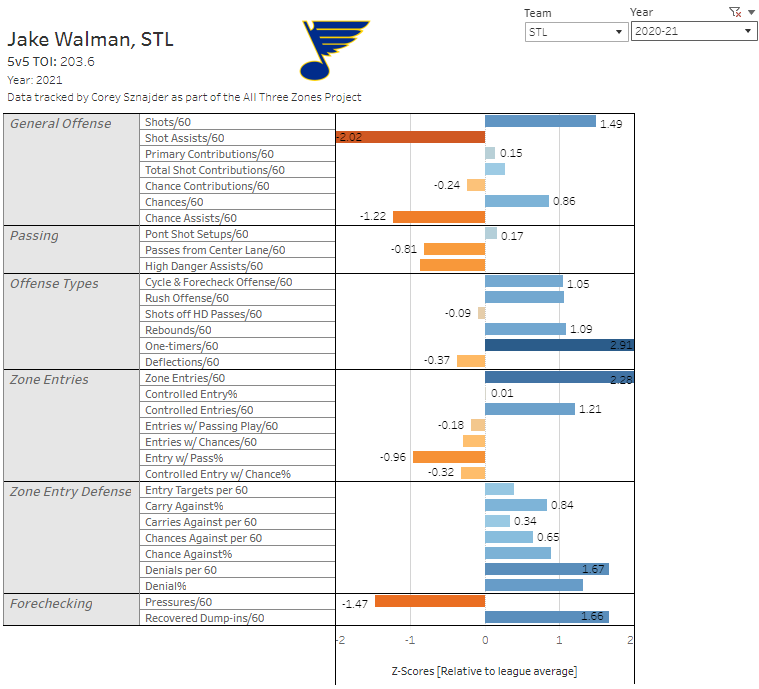
Now, it's just 203 minutes of tracked ice time but it seemed to line up with what I saw on the ice. It seemed I thought he was better in transition (controlled entries), but he wasn't bad by any means, and that's enough to work with.
Fast forward a year and Walman was skating under 12 minutes a game for St. Louis. For a team with Cup aspirations, it seemed he was disposable, and he was sent to Detroit in the Nick Leddy trade. There he earned nearly 17:30 a night, by far a career-best for him, posting 4 points in 19 games. In reality, even for his low ice time, Walman has never produced well. There's a reason for that: over the last three years, among 224 defencemen with at least 950 minutes of 5-on-5 ice time, he's 223rd in on-ice shooting percentage (the team's shooting percentage with him on the ice). There's little enough ice time here that it could very well just be bad luck or poor teammate distribution.
Regardless, Walman had another good season by some of the tracking metrics described above. This is what it looked like:
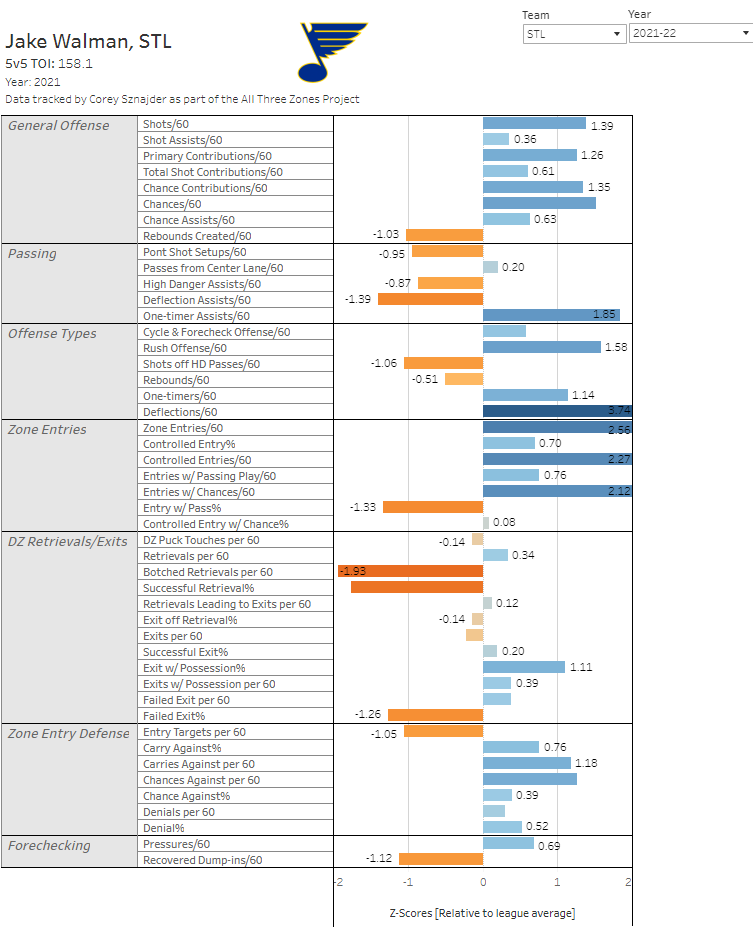
He improved his shot assist rate greatly (the rate his passes turn into team shots), which includes scoring chance assists. He was still very good at denying the blue line, as he was in COVID 2021, and improved his controlled zone entry rates as well. Despite not being a huge sample in either year, there are now two seasons of tracking data showing a pretty good all-around defenceman.
This is part of the reason I'm high on Walman. It seems as if he's developing his skills at the NHL level and improving with each passing season.
We should note that having some strong tracking data metrics does not guarantee NHL success. Troy Stecher was above average with controlled entries and shot assist rate for years but poor defence has kept his NHL role very inconsistent. Brandon Montour has typically had strong zone entry/exit rates but suffered from the same issue as Stecher: giving up the blue line too much. A coach will see that happen and a player's role can suffer because of it (even if Montour is a full-time NHLer). Haydn Fleury has average-to-good rates in these metrics for most of his career but still can't lock down a full-time role. These things do happen; good tracking stats don't guarantee a good NHL career.
With that said, Walman signing a one-way deal seems to put the third-pair role in his grasp once he returns from his shoulder injury. Detroit's forward group greatly improved in the offseason and with Olli Maatta on a one-year deal, he could be dealt at the trade deadline. Walman could start the year injured and end up on the second pair by March. He isn't someone to draft in one-year fantasy leagues unless they are super-deep rosters, but he's someone to keep in mind as the season wears on. I think there's a good offensive defenceman here and he could have a solid role over the final couple months of the campaign (Simon Edvinsson could throw a wrench in that, though).
*
The Carolina Hurricanes got some very bad news on Max Pacioretty late on Tuesday night:
A six-month timeline would have the winger return around Valentine's Day in 2023. That is a very long absence for a player that is turning 34 years old in November; he would, at best, miss about two-thirds of the season.
We are not doctors here at Dobber Hockey, but anyone that has watched and/or played sports long enough knows how brutal an Achilles injury is. Erik Karlsson famously suffered his cut Achilles nearly a decade ago – time flies, huh? – and it took him a season before he was himself again (though his nearly one-legged playoff performance will forever be remembered). Nate Thompson suffered a torn Achilles six years ago and it took him over seven months to return. Peyton Krebs took about six months to return from his a few years back but didn't seem to miss a beat. All this is to say, the injury degree can vary, the return can be a 3-4 months or 7-8 months, and there's no guarantee the player hits the ground running, so to speak, when they do get back. Let's cross our fingers Patches is back after Christmas and is his normal self. No one likes to see injuries affect careers.
How this impacts the lineup is another question. He was assuredly going to line up on the left wing and that would open a spot either on the first or second line. Because of his spot in the lineup, this would have likely moved the recently-signed Martin Necas to the third line. (We'll get to Necas in a minute but Alex MacLean gave me some inspiration to write about him with his Ramblings yesterday.) Now that Pacioretty is gone, it seems to me that a spot has opened for Necas in the top-6:
Teravainen-Aho-Jarvis
Svechnikov-Kotkaniemi-Necas
Kase-Staal-Fast
Having depth is something that has helped Carolina excel for years now and this is no different. Being able to keep a really good top-6 together, with a good checking line, despite losing a 30-goal, 70-point winger is a hallmark of a great team.
Not for nothing but this could hurt Kotkaniemi. He had the potential to be flanked by two excellent wingers in Svechnikov and Pacioretty. Now, I would wager he gets Necas on his wing and though his upside is high, he's not a Max Pacioretty. Not yet (or probably ever).
For another lineup impact, let's work with some assumptions. If they run a 4F/1D top PP unit, we can assume Brent Burns is the blue liner with Sebastian Aho, Teuvo Teravainen, and Andrei Svechnikov as three of the forwards. Our Frozen Tools has them (with now-Ranger Vincent Trocheck) as far-and-away the most used combination last year and the power play was excellent. It seems fair to say that they'll just replace the blue line and Trocheck and move along.
The easy answer is they'll slide Jarvis on to the top PP unit and I really wish that were so. I'm of the opinion, as I've often stated in these Ramblings, that he could have been the top rookie to play in 2021-22 and he has sky-high scoring upside in his future. The problem is that he doesn't play the role that Trocheck did on the power play, which is a net-front role. He would typically play the top of the circles and it's not impossible to change roles, but coaches like to keep things as simple as they can, especially when they work as well as the Carolina power play.
*
We do have to talk about Martin Necas. He had a good rookie season with 36 points in 64 games back in 2019-20, and followed that up with a great sophomore campaign, posting 41 points in 53 games. The 12th overall pick from 2017, following a great AHL season in 2018-19 with 52 points in 64 games, looked to be on his way to being a top-line producer.
That hit a wall in 2021-22. He posted 40 points in 78 games, dropping 0.26 points per game from the year before, and lower than his rookie year. He saw a decline in ice time that got worse as the season wore on, dropping to 15:43 a night over his final 40 games. The team had Cup aspirations and could not wait for him to figure his game out. He was entirely shoved off the top PP unit and that didn't help matters.
So, what went wrong? Let's check, with data from Natural Stat Trick.
The tweet referenced by Alex in that Ramblings linked above was a mini-thread. Sznajder pointed out that while a lot of Necas's tracking stats were strong, one area stood out as very weak, and that's scoring chance contributions (either his own individual scoring chances or those he generated for others). This is what it looks like from 2021-22 with scoring chance contributions highlighted:
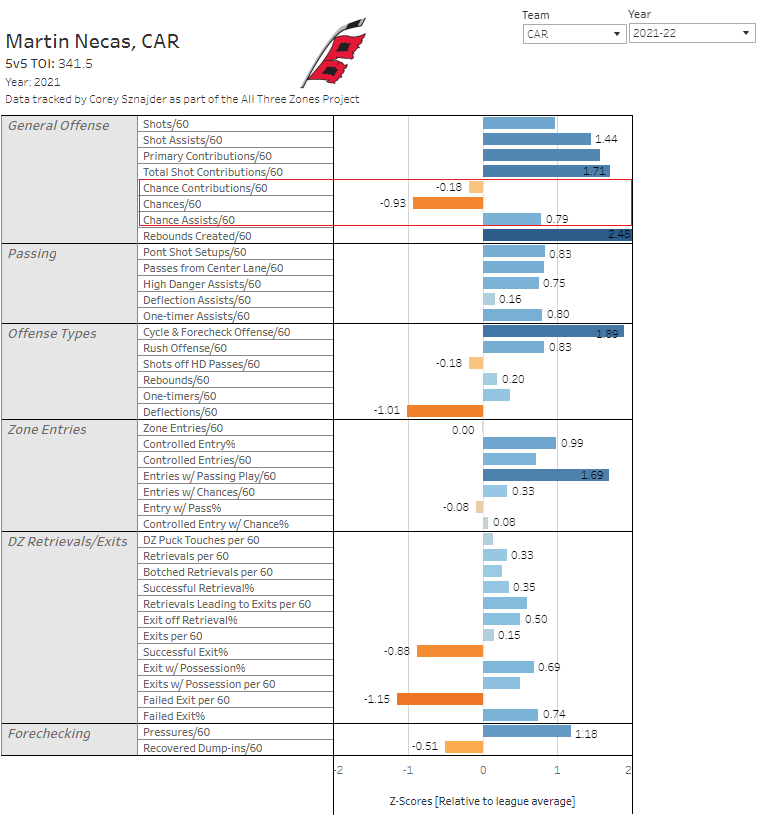
We can see that he actually assisted on a good number of chances but didn't get many of his own, leaving his overall contributions below average. Despite strong controlled entry rates, and shot assist rates, and playmaking rates, they weren't generating a lot of scoring chances. That is what a genuine perimeter player looks like. HockeyViz can help us illustrate this by using their shot heat maps to see where he was shooting from in 2021-22:
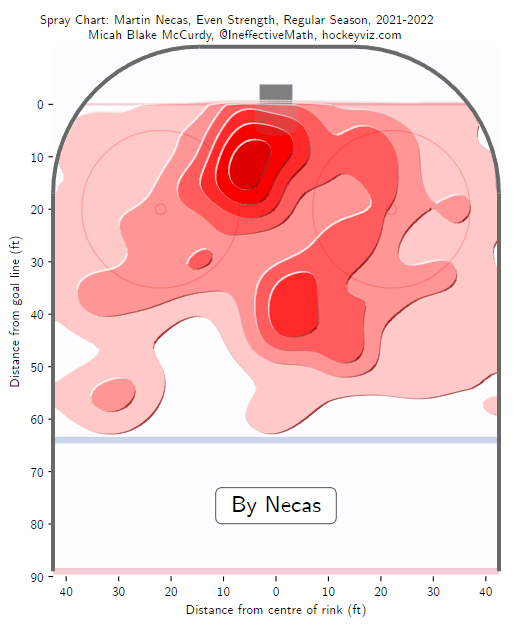
That's a reasonable amount from the net-front, but also a lot of shots from all over the offensive zone, outside the dots/circles. For a reference, here is what Sebastian Aho's looked like in 2021-22, a guy that scored 37 goals, his third 30-goal season in six years (would have had four such seasons were it not for the shortened COVID 2021 season):
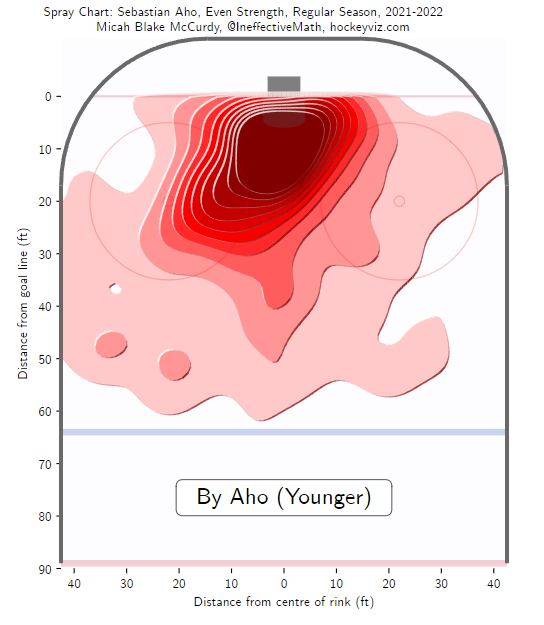
Sure, there are some shots from distance, but the vast, vast majority are below the circles and between the dots. He shoots from prime scoring areas and the results are obvious. On the flipside, because of his tendency to shoot from distance, Necas is shooting 7.9% at 5-on-5 over the last two seasons. That is 13th among regular Carolina forwards and 294th out of 380 qualified forwards. He's a good playmaker but his scoring ability is very much in doubt.
That playmaking is a strength, though. As mentioned, he was good in helping teammates generate scoring chances, and that meant he finished second on the team (a shade behind Aho) in assists per 60 minutes at 5-on-5. League-wide, his assist rate was tied for 58th among 280 forwards, or a top-line rate. He exceeded names like Ryan Strome, Mathew Barzal, and the great Leon Draisaitl. However, on a team filled with top-end offensive players, he fell into the muddy middle and that reduced his role, ice time, and thus his production.
Finally, there is his power play role. As mentioned earlier, he lost his top PP role entirely as the season wore on. Not that he was locked on that unit, but he was at least getting some sparse opportunities. That didn't happen in the second half of the season. The team didn't do well with him on the PP, either, scoring just 4.2 goals per 60 minutes. In his first two seasons, the team scored at nearly twice the rate (8.3 per 60). In truth, the top PP unit has struggled with him there, as the team's PP scoring rate with him and Sebastian Aho on the ice over Necas's career is 4.7, whereas it's 10.8 when Aho is on the ice without him. He hasn't turned into a great power-play engine yet and the team knows that.
It’s why I wonder if he earns the top PP role. He could play a pseudo-net-front position as he has at times, but will he be any good at it? Would they be better trying Jesperi Kotkaniemi? Or just seeing if Jarvis could excel with it? It might not be the best use of their skills but unless Necas improves his power play prowess, there are only so many spots to go.
There's a world where this injury to Pacioretty kicks down the door for Necas's fantasy value. He could slide on the second line and top PP unit and threaten 20 goals/60 points like fantasy owners have hoped he would. The power play role will decide what his upside is.
All of this said, there is clearly a talented playmaking winger here. There are deficiencies to his game that he needs to improve to really reach that next level, though. He will get a chance to do it with Pacioretty out of the lineup and his fantasy upside looks a lot better now than it did two days ago.

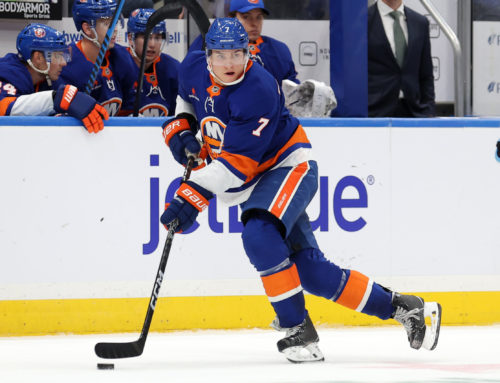

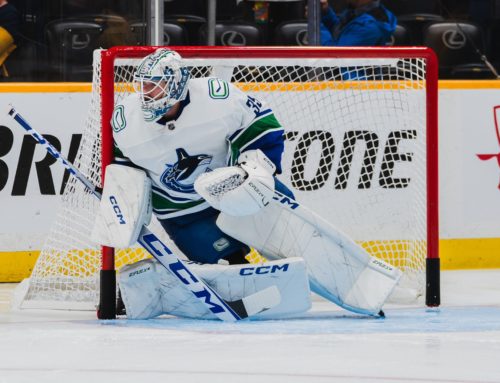

 FLA
FLA CHI
CHI NYR
NYR PIT
PIT L.A
L.A COL
COL MTL
MTL CAR
CAR CBJ
CBJ NSH
NSH PHI
PHI TOR
TOR UTA
UTA NYI
NYI
